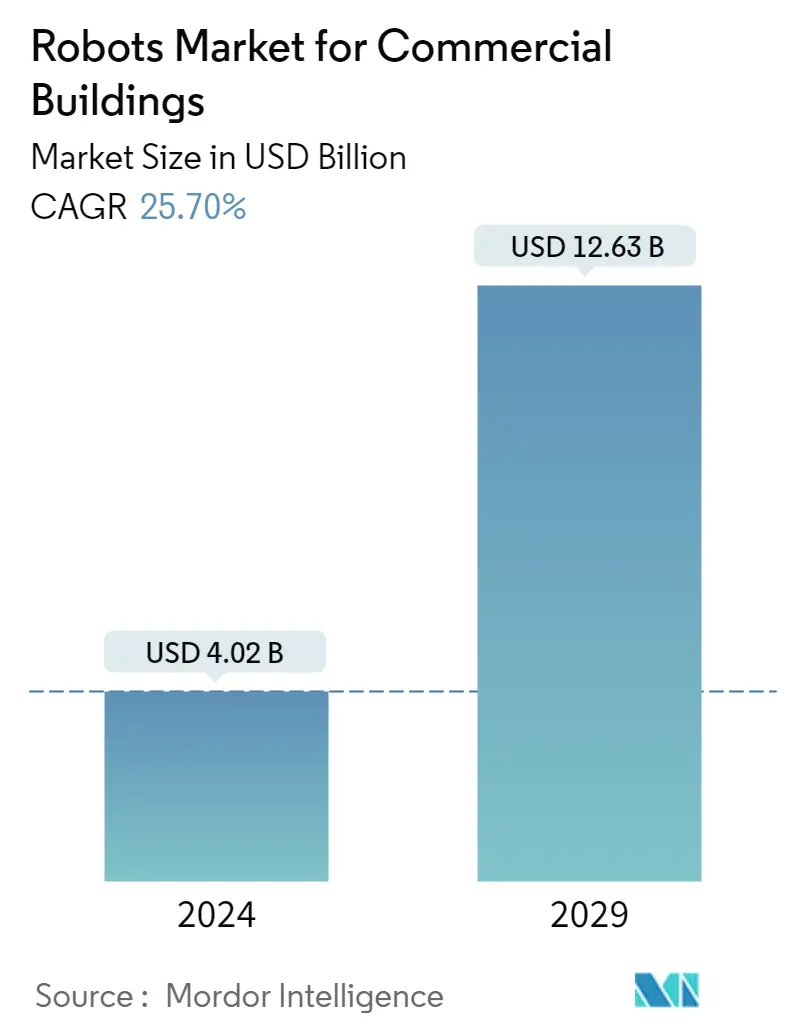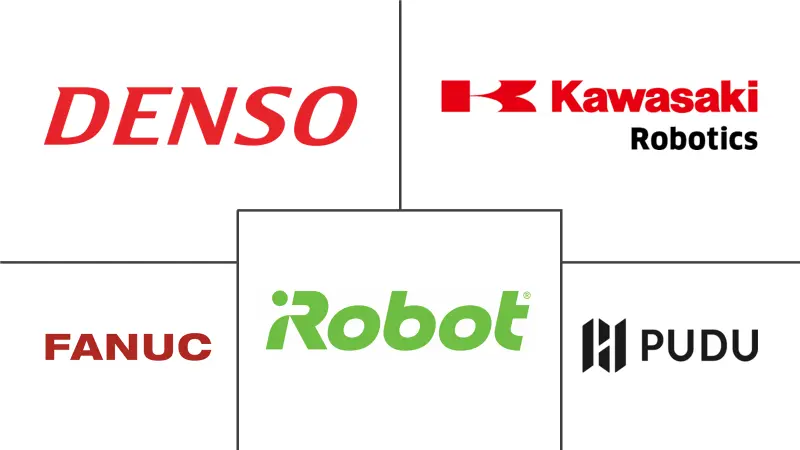Market Size of Robots Industry for Commercial Buildings

| Study Period | 2019 - 2029 |
| Market Size (2024) | USD 4.02 Billion |
| Market Size (2029) | USD 12.63 Billion |
| CAGR (2024 - 2029) | 25.70 % |
| Fastest Growing Market | Asia Pacific |
| Largest Market | North America |
| Market Concentration | Low |
Major Players
*Disclaimer: Major Players sorted in no particular order |
Commercial Buildings Robots Market Analysis
The Robots Market for Commercial Buildings Industry is expected to grow from USD 4.02 billion in 2024 to USD 12.63 billion by 2029, at a CAGR of 25.70% during the forecast period (2024-2029).
- The increasing technological developments and the ongoing labor shortage encourage facility management companies to switch to automated tools for higher cleanliness, service, and technological capabilities.
- Automation and AI technology have transformed many industries, from healthcare to banking to retail, and while commercial buildings were not early adopters, they are definitely another industry beginning to benefit from advanced technology for improving efficiency.
- Commercial robots are widely used for cleaning tasks such as sweeping, mopping, and vacuuming. These robots can be programmed to clean specific areas at specific times, reducing labor costs and improving efficiency.
- Serving robots are also becoming increasingly popular in restaurants, as they provide improved efficiency, contactless service, increased capacity, and are cost-effective. These robots can carry multiple dishes or drinks at once, which helps speed up service and reduce wait times for customers.
- Due to such reasons, various vendors regularly make technological advancements and focus on strategic investments to expand their product offerings and cater to varying customer needs. For instance, in February 2023, Kum & Go announced a partnership with ICE Cobotics to deploy automated floor-cleaning robots. By integrating the autonomous equipment, the brand will help free up associates from repetitive work and allow them to focus on keeping shelves and coolers fully stocked, delivering fresh food offerings, and increasing engagement with in-store customers.
Commercial Buildings Robots Industry Segmentation
Robots manage many of the core operations in commercial applications, which is crucial. The use of robots in commercial buildings has witnessed a surge in demand in the past decade. This is due to the rising convergence of robotics and artificial intelligence, including planning and search, probabilistic inference, localization, tracking, and control.
The scope of the report includes the use of different kinds of robots in commercial buildings based on their type and their applications in commercial buildings. The study also tracks the key market parameters, underlying growth influencers, and major vendors operating in the industry, which supports the market estimations and growth rates over the forecast period. The study further analyzes the overall impact of COVID-19 on the ecosystem. The robots market for commercial buildings is segmented by type of robots (floor cleaning robots, disinfection robots, retail shelf management robots, serving robots, building service robots), end-user vertical (retail, restaurants, healthcare facilities, airports), and geography (North America, Europe, Asia-Pacific, Latin America, Middle East and Africa). The market sizes and forecasts are provided in terms of value (USD) for all the above segments.
| Type of Robots | |
| Floor Cleaning Robots | |
| Disinfection Robots | |
| Retail Shelf Management Robots | |
| Serving Robots | |
| Building Service Robots |
| End-user Verticals | |
| Retail | |
| Restaurants | |
| Healthcare Facilities | |
| Airports | |
| Other End-user Verticals |
| Geography | |
| North America | |
| Europe | |
| Asia-Pacific | |
| Latin America | |
| Middle East and Africa |
Robots Market for Commercial Buildings Size Summary
The robots market for commercial buildings is experiencing significant growth, driven by technological advancements and the need for increased efficiency in facility management. As industries like healthcare, banking, and retail have embraced automation and AI, commercial buildings are now leveraging these technologies to enhance service delivery and operational efficiency. The use of robots for cleaning tasks, such as sweeping, mopping, and vacuuming, is becoming commonplace, offering benefits like reduced labor costs and improved cleanliness. Additionally, serving robots are gaining traction in the hospitality sector, providing contactless service and increasing operational capacity. Companies are investing in strategic partnerships and technological innovations to meet the diverse needs of their customers, as seen in collaborations like Kum & Go's partnership with ICE Cobotics.
North America stands out as a leading market for robotic solutions in commercial buildings, with a strong economy and high demand in sectors like retail, healthcare, and hospitality. The region's focus on health and safety, coupled with the need to reduce chemical exposure and workplace hazards, is driving the adoption of cleaning robots. Major players such as iRobot Corporation, Omron Adept Technologies Inc., and Pudu Robotics dominate the market, expanding their reach through strategic initiatives and product innovations. The market is characterized by fragmentation, with numerous competitive players and ongoing developments in robotic technology. Companies are continuously enhancing their product offerings, as demonstrated by iRobot's introduction of the Roomba Combo j7+ and Pudu Robotics' expansion into new markets and industries.
Robots Market for Commercial Buildings Market Size - Table of Contents
-
1. MARKET INSIGHTS
-
1.1 Market Overview
-
1.2 Industry Attractiveness - Porter's Five Forces Analysis
-
1.2.1 Bargaining Power of Buyers/Consumers
-
1.2.2 Bargaining Power of Suppliers
-
1.2.3 Threat of New Entrants
-
1.2.4 Threat of Substitute Products
-
1.2.5 Intensity of Competitive Rivalry
-
-
1.3 Industry Value Chain Analysis
-
-
2. MARKET SEGMENTATION
-
2.1 Type of Robots
-
2.1.1 Floor Cleaning Robots
-
2.1.2 Disinfection Robots
-
2.1.3 Retail Shelf Management Robots
-
2.1.4 Serving Robots
-
2.1.5 Building Service Robots
-
-
2.2 End-user Verticals
-
2.2.1 Retail
-
2.2.2 Restaurants
-
2.2.3 Healthcare Facilities
-
2.2.4 Airports
-
2.2.5 Other End-user Verticals
-
-
2.3 Geography
-
2.3.1 North America
-
2.3.2 Europe
-
2.3.3 Asia-Pacific
-
2.3.4 Latin America
-
2.3.5 Middle East and Africa
-
-
Robots Market for Commercial Buildings Market Size FAQs
How big is the Commercial Buildings Robots Market?
The Commercial Buildings Robots Market size is expected to reach USD 4.02 billion in 2024 and grow at a CAGR of 25.70% to reach USD 12.63 billion by 2029.
What is the current Commercial Buildings Robots Market size?
In 2024, the Commercial Buildings Robots Market size is expected to reach USD 4.02 billion.

